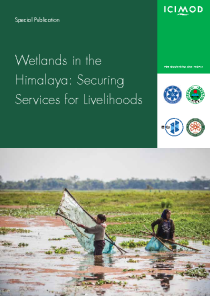Wetlands in the Himalaya: securing services for livelihoods
 Wetlands cover 5–10% of the earth’s terrestrial surface. They are important ecosystems that supply goods and services for human wellbeing. Despite their rich biodiversity, social and economic values, wetlands are in immense pressure, and are undergoing constant degradation due to several anthropogenic forces, such as urban development, expansion of agricultural land and industrial pollution. The global extent of wetlands in the 20th century is estimated to have declined by 64–71%, and losses and degradation of wetlands continue worldwide, which will eventually have significant impacts on the supply of ecosystem services and affect the livelihoods of people [Ramsar Secretariat 2015: State of the World’s Wetlands and their Services (Task No. 18)]. In Asia alone, about 5,000 km2 of wetlands vanish each year, with substantial impacts on ecosystem services, biodiversity and the livelihoods of people. In the Hindu Kush Himalaya (HKH) region, there is only limited information available on the overall status of wetlands and resource exploitation because of the difficult geographic terrain and harsh climatic conditions. Thus, to generate a better understanding of wetlands in the region, a common platform was sought to exchange information, learnings and research findings. ICIMOD, in collaboration with the Kunming Institute of Botany (KIB) and the Chengdu Institute of Biology (CIB) under Chinese Academy of Sciences (CAS), and the Yunnan Institute of Environmental Science (YIES), organized a Regional Expert Consultative Symposium on ‘Managing Wetland Ecosystem in the Hindu Kush Himalaya: Securing Services for Livelihoods’ in Dali, Yunnan Province of China.
Wetlands cover 5–10% of the earth’s terrestrial surface. They are important ecosystems that supply goods and services for human wellbeing. Despite their rich biodiversity, social and economic values, wetlands are in immense pressure, and are undergoing constant degradation due to several anthropogenic forces, such as urban development, expansion of agricultural land and industrial pollution. The global extent of wetlands in the 20th century is estimated to have declined by 64–71%, and losses and degradation of wetlands continue worldwide, which will eventually have significant impacts on the supply of ecosystem services and affect the livelihoods of people [Ramsar Secretariat 2015: State of the World’s Wetlands and their Services (Task No. 18)]. In Asia alone, about 5,000 km2 of wetlands vanish each year, with substantial impacts on ecosystem services, biodiversity and the livelihoods of people. In the Hindu Kush Himalaya (HKH) region, there is only limited information available on the overall status of wetlands and resource exploitation because of the difficult geographic terrain and harsh climatic conditions. Thus, to generate a better understanding of wetlands in the region, a common platform was sought to exchange information, learnings and research findings. ICIMOD, in collaboration with the Kunming Institute of Botany (KIB) and the Chengdu Institute of Biology (CIB) under Chinese Academy of Sciences (CAS), and the Yunnan Institute of Environmental Science (YIES), organized a Regional Expert Consultative Symposium on ‘Managing Wetland Ecosystem in the Hindu Kush Himalaya: Securing Services for Livelihoods’ in Dali, Yunnan Province of China.
